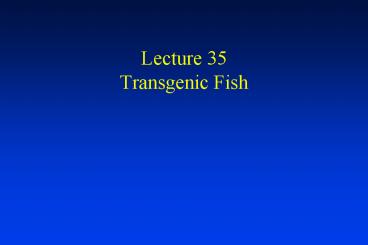Lecture 35 Transgenic Fish - PowerPoint PPT Presentation
1 / 16
Title:
Lecture 35 Transgenic Fish
Description:
Lecture 35 Transgenic Fish Steps for Making Transgenic Fish Steps for Making Transgenic Fish Steps for Making Transgenic Fish Steps for Making Transgenic Fish Steps ... – PowerPoint PPT presentation
Number of Views:4004
Avg rating:3.0/5.0
Title: Lecture 35 Transgenic Fish
1
Lecture 35Transgenic Fish
2
Steps for Making Transgenic Fish
Step 1. Decide Gene/Protein to Add. Step 2.
Decode Protein and Translate to cDNA Code.
cDNA
Protein
3
Steps for Making Transgenic Fish
Step 3. Prepare Gene Construct.
Gene Construct
Protein Gene
Promoter Gene
4
Steps for Making Transgenic Fish
Step 4. Insert Construct into Bacterial Plasmid.
5
Steps for Making Transgenic Fish
Step 5. Insert Plasmid in Bacterial Strain
Make Billions of Copies.
6
Steps for Making Transgenic Fish
Step 6. Isolate Plasmids from Bacteria and
Cleave into Linear Cassettes.
7
Steps for Making Transgenic Fish
Step 7. Insert Over 1 Million Cassettes into
Each Newly Fertilized Egg.
8
Steps for Making Transgenic Fish
Step 8. Incubate and Grow Out Surviving Fry.
9
Steps for Making Transgenic Fish
Step 9. Find the Transgenics and Select Fish(s)
with Desired Characteristics.
10
Steps for Making Transgenic Fish
Step 10. Breeding Program to Stabilize Transgene.
11
Steps for Making Transgenic Fish
- Step 11. Seek Regulatory and Public Approval.
- Develop Food Safety Data
- Design Reliable Environmental Safety Measures
- Effectiveness Target Animal Safety Data
- Convince Regulatory Agencies (CVM and Foreign)
- Convince Producers and Customers to Buy
12
Current Limitations
- Random insertion of short gene construct
- Variable numbers of copies inserted
- Insertion sites different for each individual
- Limitations
- Difficulty stabilizing genetic modification in a
breeding population - Uncontrolled transgene expression, zero
withdrawal time, simple modifications only - Insertion site effects on other genes
13
Current Limitations
- Need for extensive breeding program
- Before and after modification is stabilized
- Multiple generations at 2 years each
- Data on production - fish needed for regulatory
reviews - Control over unlicensed, unpatented breeding
- Develop breeding biocontainment strategies
14
Current Limitations
- Environmental concerns about releases
- Competition with wild populations
- Gene introgression effects on wild gene pool
- Ecological disruptions due to changes in prey
size and other niche requirements - Containment and biocontainment
- Engineering approaches are involved unproven
- Biocontainment research still needed
15
Current Limitations
- Public International Acceptance
- Attitude differs for GM animals vs. plants
- Different attitudes for optional/premium vs.
commodity food products food vs. drugs - Labeling choice
- Variation among countries
- Ethical concerns stronger for animals than plants
16
Current Limitations
- Competition from more widely accepted alternative
approaches - Genetic screening selective breeding
- Ploidy changes triploid, tetraploid, etc.
- Improved nutrition management
- Orally active growth promoters that can be
withdrawn pre-harvest































